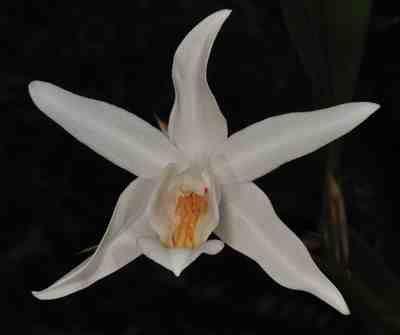A look alike plant of its species, but very rarely found. The only observed difference is mainly with the flowers. The sepals and petals are not much undulated, slightly wavy only. The other difference is with the colouration of the disc between the side lobes, it is very pale yellow or in some cases not at all noticeable.

The Pursuit
Sir. George King and Robert Pantling reported about this variety in their monumental work. However, till date there was no mention of this variety anywhere. Thinking it is still there in the wild, I along with my friend from the village made several visits to the jungle where we found the species in abundance, everyday returning with a hope to find the variety. By the end of the season, we found a few rather huge pendulous clusters of white flowers relatively at a low altitude and in bloom. As it was around 20 feet high from the ground, we were not able to notice the lip colour. “No ways out, climb up the tree only”, commanded my friend. We both climbed that huge tree with the help of a rope encircled around it. He was the one who reached the tree top first and requested me in a very soft tone, “Swamiji, please go down and come up with your camera”, “I found what you were looking for”. Rest was something unimaginable, I reached the ground in hardly 2 seconds, picked up the camera and accessories went up the tree like an expert climber…… thanks I reached the top without a fall!!!!. Yes, it was the variety one, the one with pale yellow mid lobe or in many cases white itself. The flowers we got were also fresh, with no markings or dirt on its sepals and petals, thus producing this perfect photograph, for the first time.








